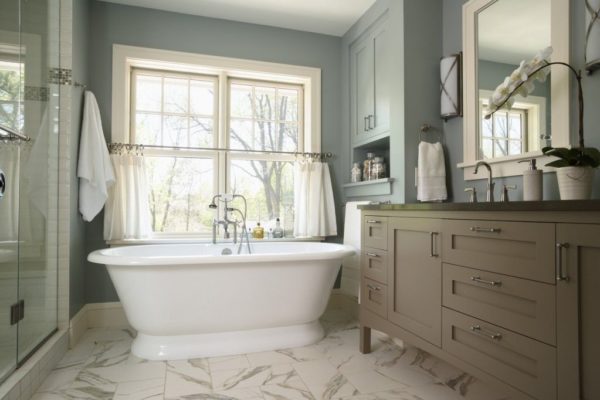How To Design a Bathroom in My Place: A Step-By-Step Guide to Creating Your Dream Bathroom
Designing the perfect bathroom in your own home is a dream many of us share. A well-designed bathroom not only adds to the overall aesthetics of your house but also enhances its functionality. However, transforming this dream into reality can be quite a challenging task. To help you achieve your goal, we have put together a comprehensive step-by-step guide on how to design a bathroom in your place. Whether you’re looking to create a stylish guest bathroom, a spa-like retreat, or simply update your existing space, we’ve got you covered.
 Step 1: Understand the Importance of Bathroom Design
Step 1: Understand the Importance of Bathroom Design
Before diving into the design a Bathroom process, it’s crucial to recognize the significance of a well-designed bathroom. Gone are the days when bathrooms were solely functional spaces. Modern bathrooms serve as personal sanctuaries, providing relaxation, rejuvenation, and self-care in addition to fulfilling their basic purposes. A thoughtfully designed bathroom not only adds value to your home but also enhances your daily routine.
Step 2: Set Your Goals and Priorities
Every bathroom design project should begin with a clear understanding of your goals and priorities. Ask yourself the following questions:
- What is the primary purpose of this bathroom?
- Who will be using it, and what are their specific needs?
- Do you prefer a traditional, contemporary, or a unique style?
- Are you looking to maximize storage or create an open and spacious feel?
- What is your budget for this project?
By defining your objectives, you can tailor your design to meet your specific requirements and preferences.
Step 3: Gather Inspiration
Inspiration is the key to creating a bathroom that reflects your unique style. Begin by collecting ideas and inspiration from various sources:
- Look for design inspiration in hotels, restaurants, and boutique cafes. Take photos of bathrooms you admire during your travels.
- Explore interior design magazines, websites, and social media platforms like Pinterest and Instagram for trendy bathroom designs.
- Seek recommendations and insights from friends and family members who have undertaken bathroom renovation projects. Learn from their experiences to avoid common pitfalls.
Step 4: Create a Design Concept
With a wealth of inspiration at your disposal, it’s time to create a design concept for your bathroom. Your chosen design concept will serve as the foundation for all your design decisions, from selecting fixtures to choosing color schemes. Here are a few design concepts to consider:
- Period Style: Embrace a vintage or historical design with classic fixtures and timeless elegance.
- Contemporary: Opt for sleek, minimalist designs with clean lines and modern fixtures.
- Spa Retreat: Transform your bathroom into a serene oasis with calming colors, natural materials, and luxurious amenities.
Step 5: Plan Your Layout: Design a Bathroom
The layout of your bathroom is a critical aspect of the design. Consider the following tips when planning your bathroom layout:
- Functionality: Ensure that the layout caters to the specific needs of the users. For example, if it’s a family bathroom, prioritize storage and durability. If it’s a guest bathroom, focus on aesthetics and convenience.
- Traffic Flow: Plan the layout to allow for smooth traffic flow within the bathroom. Avoid placing fixtures too close together, and ensure there’s enough space to move comfortably.
- Storage Solutions: Integrate smart storage solutions into your design. Vanity cabinets, shelves, and built-in niches can help keep your bathroom organized and clutter-free.
Step 6: Select Fixtures and Materials
Choosing the right fixtures and materials is where your design concept comes to life. Pay attention to the following elements:
- Fixtures: Select high-quality fixtures that align with your chosen style. Consider options like modern faucets, stylish sinks, and efficient toilets.
- Countertops and Flooring: Choose materials that are both aesthetically pleasing and practical. Granite, quartz, and marble countertops are popular choices, while ceramic tiles are versatile for flooring.
- Color Palette: Decide on a color scheme that complements your design concept. Light colors can make a small bathroom feel more spacious, while bold colors can add personality.
Step 7: Create a Lighting Plan: Design a Bathroom
Lighting plays a crucial role in bathroom design. A well-thought-out lighting plan can enhance the overall ambiance and functionality of your bathroom. Consider the following lighting options:
- Task Lighting: Install task lighting around the vanity and mirror for grooming tasks.
- Ambient Lighting: Use ambient lighting fixtures, such as overhead lights or wall sconces, to create a warm and inviting atmosphere.
- Accent Lighting: Add accent lighting to highlight specific design elements, like artwork or architectural features.
Step 8: Consider Eco-Friendly Options
Incorporating eco-friendly features into your bathroom design is not only environmentally responsible but also cost-effective in the long run. Explore options like low-flow faucets, energy-efficient lighting, and water-saving toilets to reduce your environmental footprint and save on utility bills.
Step 9: Plan for Ventilation: Design a Bathroom
Proper ventilation is essential to prevent moisture buildup, mold, and odors in your bathroom. Ensure that your design includes adequate ventilation solutions, such as exhaust fans or windows that can be opened for fresh air circulation.
Step 10: Seek Professional Help
While DIY bathroom design is possible, seeking professional guidance can streamline the process and ensure that your vision is executed flawlessly. Consider consulting with an interior designer or a bathroom remodeling expert to bring your design to life.
Step 11: Budget and Timeline
Establish a realistic budget for your design a Bathroom project and create a timeline to track progress. Be prepared for unexpected expenses and delays, and allocate a contingency fund to cover unforeseen costs.
Step 12: Bring Your Design to Life
Once your design is finalized, it’s time to bring it to life. Coordinate with contractors, plumbers, and electricians to execute the renovation according to your plan. Regular communication with the professionals involved is crucial to ensure a smooth and successful project.
In conclusion, designing a bathroom in your place can be an exciting and rewarding endeavor. By following these step-by-step guidelines and considering your specific needs and preferences, you can create a bathroom that not only meets your functional requirements but also reflects your unique style. Whether you’re designing a small bathroom, planning an online bathroom layout, or embarking on a complete bathroom renovation, careful planning and attention to detail will help you achieve your dream bathroom design. So, get started on your design a Bathroom journey, and soon, you’ll have the bathroom of your dreams right in your own home.
, such rather narrow spaces also give tips for the right storage tricks. Collect suggestions from friends and family who have had similar experiences for different ideas. This prevents you from repeating the same mistakes.
How To Design a Bathroom in My Place? for more information, you can contact us!

 Step 1: Understand the Importance of Bathroom Design
Step 1: Understand the Importance of Bathroom Design